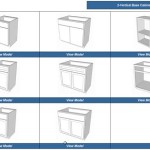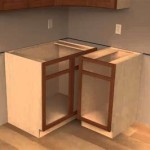Do Upper and Lower Kitchen Cabinets Need to Line Up?
Kitchen cabinets are a defining feature of any kitchen, influencing both functionality and aesthetics. One common design question revolves around the alignment of upper and lower cabinets. While a perfectly symmetrical look can be visually appealing, aligning upper and lower cabinets is not a strict requirement. Several factors influence this design choice, and understanding these factors can lead to a kitchen layout that is both practical and visually pleasing.
One key factor is the height of the ceiling. In kitchens with lower ceilings, aligning upper cabinets directly above the lower cabinets can create a cramped and oppressive feel. Raising the upper cabinets slightly, even by a few inches, can create a sense of spaciousness. This also allows for larger upper cabinets, providing more storage space without overwhelming the visual balance of the room.
The height of the homeowner also plays a significant role. Standard cabinet heights are designed for an average height, but taller or shorter individuals may find these standard dimensions inconvenient. If the upper cabinets are aligned directly above the lower cabinets, a shorter individual might struggle to reach the upper shelves comfortably. Offsetting the upper cabinets, or adjusting their height, can personalize the kitchen and improve its ergonomics.
Window placement is another critical consideration. Windows are essential for natural light and ventilation, and aligning upper cabinets with lower cabinets might obstruct a window, reducing natural light and airflow. Adjusting the height or placement of upper cabinets allows for optimal window integration, maximizing natural light and maintaining proper ventilation.
The presence of range hoods also influences cabinet alignment. Range hoods are typically positioned above the stovetop, requiring dedicated space. Aligning upper cabinets with lower units may interfere with the installation and functionality of the range hood. Offsetting the upper cabinets, or incorporating a custom cabinet design, can seamlessly integrate the range hood into the overall kitchen layout.
Architectural features, such as soffits or exposed beams, can also dictate cabinet placement. These features can create unique challenges for aligning upper and lower cabinets. Adjusting cabinet heights or employing custom cabinet designs allows for seamless integration with these existing architectural elements, maintaining a cohesive and aesthetically pleasing design.
The desired aesthetic also plays a role in cabinet alignment. While a symmetrical look can be appealing, some homeowners prefer a more asymmetrical, dynamic design. Offsetting upper cabinets can create visual interest and break up the monotony of perfectly aligned units. This can be particularly effective in kitchens with a more modern or eclectic design style.
Furthermore, functionality often trumps aesthetics in kitchen design. The primary purpose of kitchen cabinets is to provide storage, and sometimes, optimizing storage space necessitates deviating from strict alignment. Staggering upper cabinets, for instance, can create more accessible storage for specific items or accommodate variations in ceiling height.
Cost is another practical consideration. Custom cabinet solutions, while offering greater design flexibility, are often more expensive than standard, pre-fabricated units. If budget is a concern, aligning upper and lower cabinets might be the most cost-effective approach. However, carefully evaluating storage needs and prioritizing functionality can justify the investment in custom solutions that optimize storage and ergonomics.
The style of the kitchen cabinets also influences alignment decisions. Certain cabinet styles, such as shaker or flat-panel cabinets, lend themselves well to a symmetrical, aligned look. Other styles, such as more ornate or traditional designs, might benefit from a more varied arrangement of upper and lower cabinets, creating visual interest and highlighting the intricate details of the cabinetry.
Finally, consulting with a kitchen designer is highly recommended. A professional designer can assess the specific characteristics of the kitchen space, considering factors such as ceiling height, window placement, and architectural features, and provide expert guidance on cabinet placement and alignment. They can also offer valuable insights into optimizing storage solutions and maximizing the functionality of the kitchen layout.
Ultimately, aligning upper and lower kitchen cabinets is not a mandatory design rule. Several practical and aesthetic considerations influence this decision. Carefully evaluating these factors, prioritizing functionality, and considering personal preferences will lead to a kitchen design that is both visually appealing and perfectly suited to the homeowner's needs.
The decision to align upper and lower kitchen cabinets depends on a variety of factors, including ceiling height, homeowner height, window placement, range hood installation, architectural features, aesthetic preferences, desired functionality, budget constraints, and cabinet style. Therefore, a personalized approach, often aided by a professional kitchen designer, is crucial for creating a kitchen that is both beautiful and practical. Careful consideration of these factors will ensure a kitchen design that optimizes space, enhances functionality, and reflects the homeowner's unique style and needs.

Upper And Lower Cabinet Alignment

How To Install Kitchen Cabinets

Do The Upper Cabinets Need To Line Up With Base Ehow

Upper Cabinets Don T Line Up With Lower Help

Do The Upper Cabinets Need To Line Up With Base Ehow

Thinking Of Installing An Kitchen Here S What You Need To Know First

Kitchen Cabinet Sizes What Are Standard Dimensions Of Cabinets

Ask Maria About Kitchen Cabinet Uppers And Lowers In Diffe Colours

Kitchen Cabinet Doors 101 Christopher Scott Cabinetry

Here S How Install New Upper Kitchen Cabinets
Related Posts








